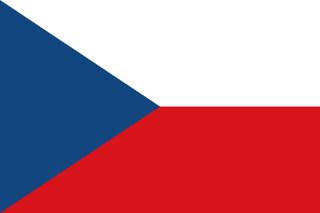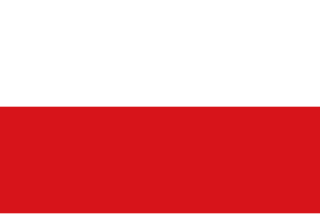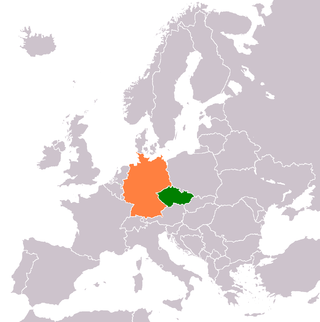
Czechoslovakia was a landlocked state in Central Europe, created in 1918, when it declared its independence from Austria-Hungary. In 1938, after the Munich Agreement, the Sudetenland became part of Nazi Germany, while the country lost further territories to Hungary and Poland. Between 1939 and 1945, the state ceased to exist, as Slovakia proclaimed its independence and Carpathian Ruthenia became part of Hungary, while the German Protectorate of Bohemia and Moravia was proclaimed in the remainder of the Czech Lands. In 1939, after the outbreak of World War II, former Czechoslovak President Edvard Beneš formed a government-in-exile and sought recognition from the Allies.

Demographic features of the population of the Czech Republic include population density, ethnicity, education level, health of the populace, economic status, and religious affiliations.

Český Těšín is a town in Karviná District in the Moravian-Silesian Region of the Czech Republic. It has about 23,000 inhabitants.
The First Czechoslovak Republic emerged from the collapse of the Austro-Hungarian Empire in October 1918. The new state consisted mostly of territories inhabited by Czechs and Slovaks, but also included areas containing majority populations of other nationalities, particularly Germans (22.95 %), who accounted for more citizens than the state's second state nation of the Slovaks, Hungarians (5.47 %) and Ruthenians (3.39 %). The new state comprised the total of Bohemia whose borders did not coincide with the language border between German and Czech. Despite initially developing effective representative institutions alongside a successful economy, the deteriorating international economic situation in the 1930s gave rise to growing ethnic tensions. The dispute between the Czech and German populations, fanned by the rise of Nazism in neighbouring Germany, resulted in the loss of territory under the terms of the Munich Agreement and subsequent events in the autumn of 1938, bringing about the end of the First Republic.
The German-speaking population in the interwar Czechoslovak Republic, 23.6% of the population at the 1921 census, usually refers to the Sudeten Germans, although there were other German ethno-linguistic enclaves elsewhere in Czechoslovakia inhabited by Carpathian Germans, and among the German-speaking urban dwellers there were ethnic Germans and/or Austrians as well as German-speaking Jews. 14% of the Czechoslovak Jews considered themselves Germans in the 1921 census, but a much higher percentage declared German as their colloquial tongue during the last censuses under the Austro-Hungarian Empire.
From the Communist coup d'état in February 1948 to the Velvet Revolution in 1989, Czechoslovakia was ruled by the Communist Party of Czechoslovakia. The country belonged to the Eastern Bloc and was a member of the Warsaw Pact and of Comecon. During the era of Communist Party rule, thousands of Czechoslovaks faced political persecution for various offences, such as trying to emigrate across the Iron Curtain.
Czechoslovakia had a peak population of 15.6 million, mainly composed of Czechs, Slovaks, Hungarians, Romani people, Silesians, Ruthenians, Ukrainians, Germans, Poles and Jews. The ethnic composition of Czechoslovakia changed over time from Sudeten Germans being the most prominent ethnicity to Czechs and Slovaks making up two-thirds of the demographic. Amongst this demographic there was also a diverse range of religions with Roman Catholic being the most prominent. This population has been found to have had an increasing growth rate that had a declining trajectory. The population density was approximately 121 persons per square kilometre with the highest population density being in Moravia of 154 persons per square kilometre.
Carpathian Ruthenia is a historical region on the border between Central and Eastern Europe, mostly located in western Ukraine's Zakarpattia Oblast, with smaller parts in eastern Slovakia and the Lemko Region in Poland.
Trans-Olza, also known as Trans-Olza Silesia, is a territory in the Czech Republic, which was disputed between Poland and Czechoslovakia during the Interwar Period. Its name comes from the Olza River.

Cieszyn Silesia, Těšín Silesia or Teschen Silesia is a historical region in south-eastern Silesia, centered on the towns of Cieszyn and Český Těšín and bisected by the Olza River. Since 1920 it has been divided between Poland and Czechoslovakia, and later the Czech Republic. It covers an area of about 2,280 square kilometres (880 sq mi) and has about 810,000 inhabitants, of which 1,002 square kilometres (387 sq mi) (44%) is in Poland, while 1,280 square kilometres (494 sq mi) (56%) is in the Czech Republic.

Border conflicts between Poland and Czechoslovakia began in 1918 between the Second Polish Republic and First Czechoslovak Republic, both freshly created states. The conflicts centered on the disputed areas of Cieszyn Silesia, Orava Territory and Spiš. After World War II they broadened to include areas around the cities of Kłodzko and Racibórz, which until 1945 had belonged to Germany. The conflicts became critical in 1919 and were finally settled in 1958 in a treaty between the Polish People's Republic and the Czechoslovak Socialist Republic.
Czechization or Czechisation is a cultural change in which something ethnically non-Czech is made to become Czech.

Hungarians constitute the largest minority in Slovakia. According to the 2021 Slovak census, 456,154 people declared themselves Hungarian, while 462,175 stated that Hungarian was their mother tongue.

Slovakization or Slovakisation is a form of either forced or voluntary cultural assimilation and acculturation, during which non-Slovak nationals give up their culture and language in favor of the Slovak one. This process has relied most heavily on intimidation and harassment by state authorities. Another method of Slovakization was artificial resettlement. In the past the process has been greatly aided by deprivation of collective rights for minorities and ethnic cleansing, but in the last decades its promotion has been limited to the adoption of anti-minority policies and anti-minority hate speech.

The First Czechoslovak Republic, often colloquially referred to as the First Republic, was the first Czechoslovak state that existed from 1918 to 1938, a union of ethnic Czechs and Slovaks. The country was commonly called Czechoslovakia, a compound of Czech and Slovak; which gradually became the most widely used name for its successor states. It was composed of former territories of Austria-Hungary, inheriting different systems of administration from the formerly Austrian and Hungarian territories.

The Polish minority in the Czech Republic is a Polish national minority living mainly in the Trans-Olza region of western Cieszyn Silesia. The Polish community is the only national minority in the Czech Republic that is linked to a specific geographical area. Trans-Olza is located in the north-eastern part of the country. It comprises Karviná District and the eastern part of Frýdek-Místek District. Many Poles living in other regions of the Czech Republic have roots in Trans-Olza as well.
After centuries of relative ethnic diversity, the population of modern Poland has become nearly completely ethnically homogeneous Polish as a result of altered borders and the Nazi German and Soviet or Polish Communist campaigns of genocide, expulsion and deportation during and after World War II. Ethnic minorities remain in Poland, however, including some newly arrived or increased in number. Ethnic groups include Germans, Ukrainians and Belarusians.

Czech–German relations are the relationship between Germany and the Czech Republic. The two countries share 815 km of common borders and both are members of the European Union, NATO, OECD, OSCE, Council of Europe and the World Trade Organization.

The Czechoslovak-Polish War, also known mostly in Czech sources as the Seven-day war was a military confrontation between Czechoslovakia and Poland over the territory of Cieszyn Silesia in early 1919.
The Czechoslovak–Hungarian population exchange was the exchange of inhabitants between Czechoslovakia and Hungary after World War II. Between 45,000 and 120,000 Hungarians were forcibly transferred from Czechoslovakia to Hungary, and their properties confiscated, while around 72,000 Slovaks voluntarily transferred from Hungary to Czechoslovakia.












